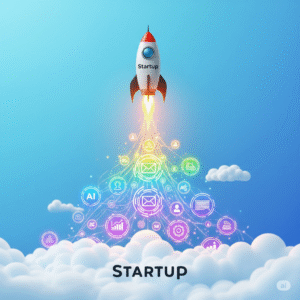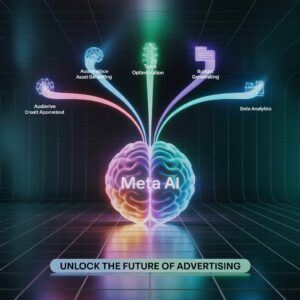Do you remember the golden age of retargeting? A user visited your site, looked at a product, and for the next seven days, you could magically show them that exact product on Facebook and Instagram. The pixel was perfect, attribution was clear, and ROAS was king. Then came the earthquake: iOS 14. Overnight, our perfectly crafted retargeting funnels shattered. Signal loss, shrinking custom audiences, and unreliable tracking became the new normal. For many marketers, it felt like retargeting was dead. (AI Retargeting Meta)
But it’s not dead; it has evolved. From the ashes of the old system rises a smarter, more resilient, and more powerful approach: AI retargeting Meta. This isn’t just a patch for a broken system; it’s a fundamental upgrade. By leveraging Meta’s Advantage+ suite, we can now move beyond the limitations of post-iOS 14 retargeting and build campaigns that are more effective than ever. This guide will walk you through exactly how to use this new generation of tools to bridge the data gap, re-engage lost customers, and turn missed opportunities into loyal patrons.
The New Reality: Understanding Post-iOS 14 Retargeting
To appreciate the solution, we must first respect the problem. The privacy-centric shifts initiated by Apple fundamentally changed the data relationship between users, apps, and advertisers, creating a new set of challenges that manual strategies simply cannot solve.
The Core Challenge of AI Retargeting Meta: Signal Loss
When users opt out of tracking on iOS, the data stream that powered our old retargeting campaigns is severed. The Meta Pixel on your website can no longer reliably tell who that user is when they return to Facebook or Instagram. This leads to several critical issues:
- Smaller Custom Audiences: Your website custom audiences (e.g., “All Visitors – 30 Days”) become significantly smaller and less accurate because they can’t capture opted-out users.
- Broken Attribution: It becomes difficult to prove that a sale was a direct result of your retargeting ad, making it harder to justify your budget.
- Ineffective Frequency Capping: You might accidentally annoy users by showing them the same ad too many times because Meta can’t accurately track who has seen what.
These challenges made classic retargeting strategies inefficient. This is the precise problem that a modern AI retargeting Meta strategy is designed to solve. The new approach relies less on perfect 1-to-1 tracking and more on sophisticated data modeling.
The Solution: What is AI Retargeting Meta?
AI retargeting Meta is a methodology that uses Meta’s machine learning to overcome the data gaps caused by signal loss. Instead of relying solely on deterministic data (a confirmed user match via the pixel), it heavily utilizes probabilistic data and modeled conversions. The AI analyzes the billions of on-platform signals from users who are trackable and builds a highly accurate predictive model.
It then uses this model to understand the behaviors of users who have opted out. Even if the AI can’t see that User A viewed a specific product, it can see that User A’s on-platform behavior is 99% identical to the thousands of other users who did view that product and eventually bought it. It then intelligently serves them a relevant ad. This synergy between pixel tracking and AI is the engine that powers modern retargeting.
Advantage+ Retargeting: Your New Intelligent Toolkit
Meta’s answer to the retargeting challenge is baked into its Advantage+ suite of products. These tools are designed to work in an environment of imperfect data, using AI to automate and optimize what we used to do manually.
How Advantage+ Retargeting Uses AI to Bridge the Data Gap
The beauty of an Advantage+ retargeting campaign is that it leans into the AI’s strength. When you feed it your business objectives, it doesn’t just rely on your dwindling custom audiences. It uses a combination of data sources:
- Your existing custom audiences: For users who are still trackable.
- On-platform engagement: It retargets users who interacted with your ads, posts, or profile directly within the app, which is unaffected by iOS tracking.
- Modeled Conversions: It finds and serves ads to users it predicts are your past visitors or cart abandoners, even without a direct pixel match.
This approach makes your retargeting more resilient and scalable. It allows you to reach a larger pool of high-intent users than you could with a simple website custom audience alone, a crucial element for any effective AI retargeting Meta strategy.
The Unsung Hero: Dynamic Retargeting Ads in an AI World
Dynamic retargeting ads are the creative fuel for your AI engine. This is where you connect your product catalog to Meta, allowing the AI to automatically create personalized ads for each user. In the context of AI retargeting Meta, their role is more important than ever. The AI can now go beyond just showing someone the exact product they abandoned in their cart.
It can act as a personal shopper, showing them related best-sellers, complementary items, or even different color variations. This dynamic approach combats ad fatigue and significantly increases the chances of conversion. If a user abandoned a pair of hiking boots, the AI might show them an ad featuring those boots, but also your best-selling hiking socks and a waterproof jacket, increasing the potential Average Order Value (AOV).
Proven Success with AI Retargeting Meta: Case Studies
The best way to understand the power of this approach is to see it in action. Here’s how two different businesses solved their retargeting woes.
Case Study 1: “WanderMore Travels” – The Online Travel Agency
This online travel agency saw its ROAS from retargeting plummet after the iOS 14 updates. Their strategy of retargeting users who viewed specific vacation packages was no longer working, as audiences were too small.
The Solution: They consolidated their fragmented retargeting campaigns into a single Advantage+ retargeting campaign. They connected their entire catalog of travel packages. The AI went to work, using dynamic retargeting ads to show users not just the package they viewed, but also similar destinations, last-minute deals, and alternative travel dates. This dynamic approach recaptured user interest effectively, recovering their retargeting ROAS by 50% within two months.
Case Study 2: “Urban Dwelling” – The D2C Furniture Store
“Urban Dwelling” had a significant abandoned cart problem. Their old retargeting strategy was simple and ineffective: show the user an ad with the exact product they left behind. This felt repetitive and failed to address why the user abandoned the purchase.
The Solution: They implemented a sophisticated AI retargeting Meta strategy. Using Advantage+ and dynamic ads, their campaign started showing abandoned cart items alongside complementary products. A user who left a sofa in their cart would see an ad featuring that sofa, but also the matching armchair and coffee table. This “complete the room” approach was far more compelling and led to a 20% increase in their cart recovery rate and a significant lift in AOV.
Your Step-by-Step Guide to Setting Up AI Retargeting on Meta
Ready to build your own AI-powered recapture campaign? Here is a beginner-friendly workflow.
- Perfect Your Data Feed: Your product catalog is the foundation. Ensure it’s uploaded to Meta Commerce Manager, completely filled out, and free of errors. For dynamic ads to work, this step is non-negotiable.
- Strengthen Your Signals with CAPI: Implement the Meta Conversions API (CAPI) alongside your Pixel. CAPI sends data from your server directly to Meta, making it more reliable than the browser-based Pixel alone. This gives your AI a cleaner dataset to learn from. A great resource for this can be found at HubSpot’s guide to marketing analytics.
- Choose an Advantage+ Campaign: When setting up a campaign with the “Sales” objective, select the “Advantage+ shopping campaign” option. This campaign type is specifically designed to leverage AI retargeting Meta.
- Inform the AI, Don’t Command It: In the Advantage+ setup, you’ll see a section for “Existing customer budget cap.” This is how you tell the AI to focus on retargeting. By setting a percentage here (e.g., 70%), you instruct the AI to spend the majority of the budget on recapturing existing customers and visitors, while still allowing it some freedom to find new ones if it sees a cheap opportunity.
- Let Dynamic Creative Shine: Instead of uploading static ads, focus on creating compelling templates for your dynamic retargeting ads. Write empathetic copy that acknowledges the user’s journey (“Still thinking it over?”, “A special offer to help you decide”).
Beyond Meta: The Holistic AI Marketing Stack
A powerful AI retargeting Meta campaign becomes even more effective when integrated with other tools. As a McKinsey report highlights, the true value of AI is realized when it’s embedded across business functions.
- For Empathetic Copy (Generative AI): Use ChatGPT or Gemini to brainstorm and write dozens of creative and copy variations for your retargeting ads. Acknowledging the user’s hesitation can make a huge difference.
- For Business Intelligence (BI Tools): Use Tableau or Power BI to analyze the long-term value of your retargeting efforts. Are these customers making repeat purchases? Does the AOV increase over time?
- For Omni-Channel Consistency: Integrate your Meta campaigns with your email/SMS marketing platform (like Klaviyo or Omnisend). A user who gets a dynamic ad on Instagram and a follow-up email with a small discount is far more likely to convert.
The Final Verdict on AI Retargeting
Retargeting is far from dead—it has simply been reborn. The brute-force methods of the past have been replaced by a more intelligent, resilient, and effective system powered by AI. The challenges presented by post-iOS 14 retargeting were a necessary catalyst, forcing the industry to evolve.
By embracing AI retargeting Meta through the Advantage+ suite, you can move past the limitations of signal loss and build a system that not only recaptures lost visitors but does so in a more dynamic and personalized way than ever before. Stop trying to glue together the pieces of a broken funnel. The future is here—it’s time to let the AI do the heavy lifting.
Meta Ads Broad Targeting: Why Trusting the AI is the New Pro Move
Advantage+ Audience for Unbeatable Prospecting Results in 2025



